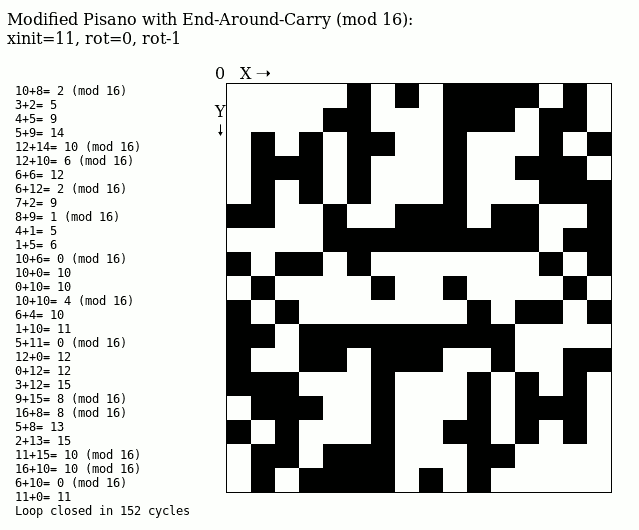How to make a PEAC sequence more "random-looking", or more scrambled ?
There seems to be an easy way : introduce a rotation operator in the feedback. Rotation is a simple bijection using quite few resources. Unfortunately, most high-level language don't define rotation so it must be emulated with a series of mask&shifts&OR, then re-optimised by the compiler. C'm'on.
But since it is a bijection, the rotation ensures that the sequence is twisted but not otherwise altered, only reordered.
The amount of reordering is limited because for a N-bit wide PEAC generator, there are only N possible rotations. But it is worth analysing the various results.
PEAC-Rx is possible only for the binary PEAC generators, the generalised PEAC can't do rotations.
Generalised PEAC have better scrambling characteristics but rotated binary PEAC might provide a good alternative, so it's suitable for hash tables for example.
Rotated PEAC is way easier to implement in HW than gPEAC because it's only a matter of swapping wires. In fact, ANY permutation of the bits is possible ! Further, the permutation can be performed by a collection of S-tables (S-boxes) borrowed from a crypto algo.
It remains to be seen if the rotation actually improves fault detection in the checksum configuration.
I'm not sure that variable rotation amounts are a good idea : at least the amount must not come from the data stream itself but from another generator (probably a smaller PEAC or LFSR). This increases the state size and the length of the orbit.
Now it's approaching crypto-style scramblers...
</nightrambling>
...
OK I did try a few things and it's not a silver bullet but the results are pretty interesting.

above is the result of this code,
There are many sensitive parameters and many combinations don't work.
TODO : try with XOR or ADD instead of ROT ?
var S = X + Y;
var C=0;
if (S >= 16) {
S -= 16;
C=1;
}
// Y = X+C; => the normal way
// The altered way:
Y = C+ ( mask & ((X<<rot) | (X>>>(bits-rot) )));
rot = 3 & (rot-1); // Dumb but enough depending on initial states
X = S;Play with the code !
Oh and by the way, the results are very different if you play with where the carry is reinjected.
C = 0;
if (S >= 16) {
S -= 16;
C=1;
}
Y = X+C;
X = S;if very different from
if (S >= 16) {
S -= 15;
}
Y = X;
X = S;because in the last case, both X and Y will have the off-by-one value and the algorithm explodes.
That's pretty significant for the gPEAC/non-binary.
 Yann Guidon / YGDES
Yann Guidon / YGDES
Discussions
Become a Hackaday.io Member
Create an account to leave a comment. Already have an account? Log In.